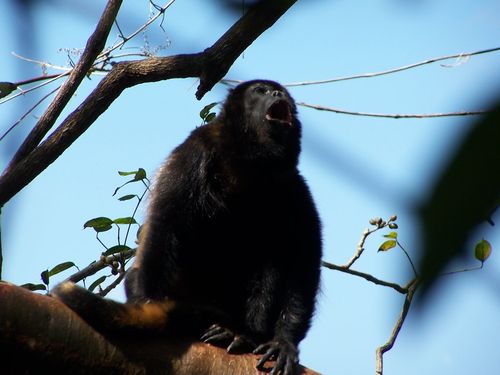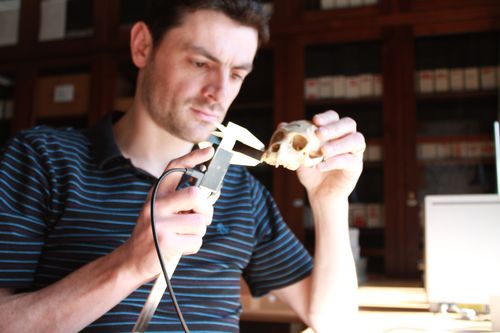Dr Jacob Dunn is Lecturer in Human Biology at the University of Cambridge and Postdoctoral Research Fellow at the Universidad Veracruzana,
Mexico. His research interests lie in the areas of primatology and evolutionary biology, encompassing and
integrating the fields of morphology, behavioural ecology, molecular ecology and
eco-physiology. He recently made use of the Library's extensive collection of wildlife recordings.
Can
you tell us about your research into the evolution of human speech?
For as long as I can remember, I have been
interested in animal behaviour. I have carried out research in a range of
related fields, including ecology, physiology and genetics, and have spent
several years carrying out fieldwork in rainforests in Peru and Mexico.
However, over the last year or so I have become interested in a new area of
research, which I am really excited about, examining communication systems in
humans and other primates.
In collaboration with Professor Leslie Knapp from
the University of Utah and Professor Tecumseh Fitch from the University of
Vienna, I am currently studying vocal communication in primates in order to
gain insight into the evolution of human speech. Speech is one of the most
distinguishing characteristics of our species. Yet, our understanding of the
evolution of this quintessentially human trait is far from complete. As most
anatomical traits associated with speech are soft tissues, which do not
fossilise, it is difficult to establish when, how and why speech evolved in the
human lineage. By applying the “comparative model” advocated by Charles Darwin
(comparing homologous and analogous structures across a wide range of different
species to draw general inferences about the evolution of traits), we use data
on the anatomy and acoustics of living primates to shed light on the evolution
of vocal communication in our extinct ancestors [1].
Currently, the research is largely focused on howler
monkeys, perhaps for obvious reasons - they are the loudest terrestrial animal
and vocal communication is clearly a very important component of their natural
behaviour. They also have a remarkable vocal anatomy, with a greatly enlarged
and specialized hyoid bone (the only bone in the vocal tract), which forms a
resonating chamber and serves to amplify their loud calls.

What
insights can be gained from studying the vocalisations of non-human primates?
People study the vocalisations of primates for a
whole host of different reasons. Some researchers are interested in what vocal
communication can tell us about animal cognition. For example, a classic study
on vervet monkeys by Robert Seyfarth et al., as far back as 1980 [2], demonstrated that some
primates use semantic communication (i.e. the ability to use signs to refer to
objects in the external world). You could think of this as monkeys using
different ´words´ for specific things in their environment (in this case
predators). More recently, studies have shown that some species may even use
some form of syntax, stringing these ´words´ together to form ´proto-sentences´
[3]. People seem to be
fascinated by the calls that animals make and what they might ´mean´.
Other researchers, are interested in the ´non-linguistic´
underlying information that may be contained within primate vocalisations (both
human and non-human primates). For example, the pitch (or ´fundamental
frequency´) of a call has long been thought to provide a cue to body size. So bigger individuals should have a deeper voice as they generally have longer
vocal folds. However, research has shown that this relationship does not
necessarily hold across all species and individuals as the larynx and vocal
folds may grow independently of body size (think of what happens to human males
at adolescence). Vocal tract resonances (or ´formant frequencies´) may be more constrained by body size, as they depend upon the size of the vocal
tract, not the vocal folds. However, there is an incredible range of
adaptations in the animal kingdom geared towards lowering the fundamental and
formant frequencies, and exaggerating body size, such as the hyoid bone of the
howler monkey, the long nose of the elephant seal and proboscis monkey, and the
descended larynx of several deer species [4].
In humans, this is a very active area of research.
We have known for a long time that women generally find men with deeper voices
more attractive (the so called ¨Barry White effect¨) and men find women with
higher pitched voices more attractive. However, voice pitch is also related to
labor market success and leadership [5, 6], trustworthiness and
dominance [7], and many other traits.
There is even evidence that men may be able to detect ovulation in women from
changes in the pitch of their voice [8]. I am currently working on
a project related to this field with Professor Benedict Jones of the University
of Glasgow.
How
did you hear about the British Library’s collection of wildlife sounds?
I was searching for howler monkey vocalisations
online and was lucky to happen across the collection. A few days later
at a project meeting I was asked whether I had checked to see whether anything
was available at museums. Fortunately, I was ready for the question and knew
that the Wildlife Sounds collection held a substantial number of recordings.
You
recently visited our Listening & Viewing Service – what did you listen to?
I listened to 49 recordings of howler monkeys, of
which 15 were used for my research. The Service then did a fantastic job of
transcribing the tapes, reels and CDs that I had listened to onto a CD, which
they sent to me through the post a week or two later.
Unidentified Howler Monkey (recorded by Richard Beard 1'20")
Black Howler Monkey chorus (recorded by Richard Ranft 2'01")
How
will these recordings help further your research?
These recordings form part of a larger database of
primate vocalisations, which we will use to analyse similarities and
differences among species. These data complement data on morphology, vocal
anatomy, behaviour, genetics and physiology, which will help us to gain a more
comprehensive picture of primate communication systems.

Links
Dr Jacob Dunn: http://www.prime.bioanth.cam.ac.uk/jacob.html
Professor Leslie Knapp: http://www.anthro.utah.edu/faculty/leslie-knapp.html
Professor Tecumseh Fitch: http://homepage.univie.ac.at/tecumseh.fitch/
Professor Benedict Jones: http://facelab.org/People/benjones
References
1. Fitch, W. T.
(2000). The evolution of speech : a comparative review. Trends in Cognitive
Sciences 6613, 258–267.
2. Seyfarth, R. M.,
Cheney, D. L., and Marler, P. (1980). Monkey responses to three different alarm
calls: evidence of predator classification and semantic communication. Science 210,
801–803.
3. Ouattara, K.,
Lemasson, A., and Zuberbu, K. (2009). Campbell ’ s monkeys concatenate
vocalizations into context-specific call sequences. Proceedings of the National
Academy of Sciences, 1–6.
4. Frey, R., and
Gebler, A. (2010). Mechanisms and evolution of roaring-like vocalization in
mammals. In Handbook of Mammalian Vocalisations, S. Brudzynski, ed. (Elsevier),
pp. 439–450.
5. Mayew, W. J.,
Parsons, C. a., and Venkatachalam, M. (2013). Voice pitch and the labor market
success of male chief executive officers. Evolution and Human Behavior, 1–6.
Available at: http://linkinghub.elsevier.com/retrieve/pii/S1090513813000238
[Accessed April 17, 2013].
6. Klofstad, C. a,
Anderson, R. C., and Peters, S. (2012). Sounds like a winner: voice pitch
influences perception of leadership capacity in both men and women.
Proceedings. Biological sciences / The Royal Society 279, 2698–704.
Available at: http://www.ncbi.nlm.nih.gov/pubmed/22418254 [Accessed January 30,
2013].
7. Vukovic, J.,
Jones, B. C., Feinberg, D. R., Debruine, L. M., Smith, F. G., Welling, L. L.
M., and Little, A. C. (2011). Variation in perceptions of physical dominance
and trustworthiness predicts individual differences in the effect of
relationship context on women’s preferences for masculine pitch in men's
voices. British journal of psychology (London, England : 1953) 102,
37–48. Available at: http://www.ncbi.nlm.nih.gov/pubmed/21241284 [Accessed
March 1, 2013].
8. Haselton, M. G.,
and Gildersleeve, K. (2011). Can Men Detect Ovulation? Current Directions in
Psychological Science 20, 87–92. Available at:
http://cdp.sagepub.com/lookup/doi/10.1177/0963721411402668 [Accessed February
7, 2013].